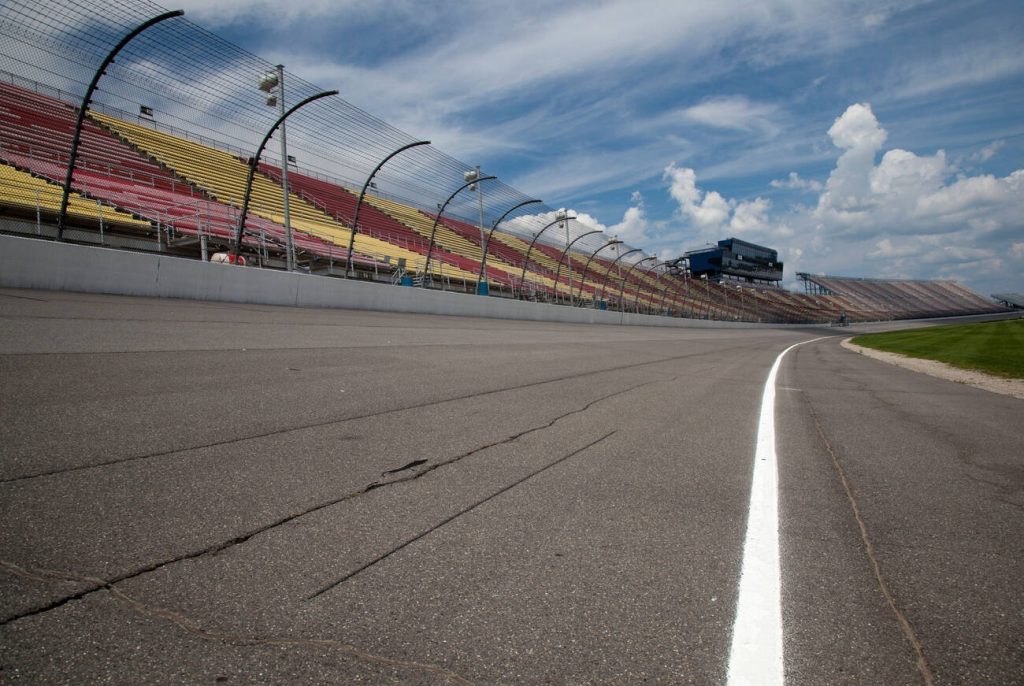Imagine yourself in the driver’s seat, gripping the wheel tightly as you race around a massive track at mind-boggling speeds. Welcome to the world of superspeedways! These tracks, over two miles long and known for their wide lanes, offer an exhilarating racing experience like no other. From Talladega to Daytona, these legendary venues have witnessed some of NASCAR’s most breathtaking finishes. But with high speeds come great risks, making every lap a heart-pounding thrill. So buckle up and get ready to explore what makes a speedway truly super!
Definition and Characteristics of Superspeedways
A superspeedway is a track that’s greater than two miles in length and is known for its high speeds and wide tracks. At these races, restrictor plate dynamics play a crucial role in controlling the speed of the cars. This adds an extra challenge for drivers as they have to master the skill of racing with restricted power. Fuel management also becomes essential on superspeedways due to the longer track length. The length creates thrilling finishes as drivers strategize their fuel consumption to make it to the end of the race without running out. Safety measures are implemented to ensure the well-being of both drivers and spectators, making for a safe and exciting superspeedway experience.
Restrictor-Plate Races and Challenges
You’ll face unique challenges in restrictor-plate races at superspeedways, where the use of restrictor plates and wrecks have led to additional restrictions being implemented. In these races, having effective restrictor plate strategies is crucial. You need to find the perfect balance between speed and control while navigating through the pack. Safety measures at superspeedways are of utmost importance due to the high speeds and potential for wrecks. Fuel management strategies also play a significant role in these races. The length of the tracks makes it essential to carefully plan fuel consumption to avoid running out before the race ends. Wreck prevention techniques require skill and experience in restrictor plate racing, as you must anticipate and react quickly to potential accidents on the track. Mastering these challenges will give you an edge when competing at superspeedways.
Fuel Strategy Challenges
Navigating fuel strategy challenges at superspeedways requires careful planning and efficient management of fuel consumption to ensure you don’t run out before the race ends. Fuel consumption becomes a key factor in determining race outcomes, making strategic planning essential. Superspeedways are known for their long track lengths, which adds an extra layer of complexity to NASCAR racing. Pit stops play a crucial role in fuel management during these races. Drivers must strategically time their pit stops to refuel without losing too much time on the track. The success or failure of these pit stops can greatly impact a driver’s chances of winning the race. Therefore, understanding how to optimize fuel consumption and make well-timed pit stops is vital for achieving favorable race results at superspeedways.
Excitement and Intrigue of Superspeedways
The combination of high speeds and wide tracks at superspeedways creates an exhilarating racing experience. Superspeedways are known for their thrilling finishes, with races often coming down to the wire. The unique experience of watching cars zoom around at incredible speeds on these expansive tracks is unmatched. Safety measures are implemented to ensure the well-being of drivers and spectators alike, adding an element of reassurance to the excitement. The wide tracks allow for plenty of room for overtaking and strategic maneuvering, making each race unpredictable and intense. Whether you’re a die-hard fan or new to NASCAR, witnessing the high-speed action at a superspeedway is sure to leave you in awe. From the roar of engines to the adrenaline-fueled atmosphere, experiencing a race at a superspeedway is truly a one-of-a-kind thrill that can’t be replicated anywhere else.
Disclaimer and Gambling
Please note that the content provided regarding gambling and betting is for entertainment purposes only and should be viewed as individual opinions, not guaranteed ways to make money. Gambling can have a significant impact on individuals and society as a whole. It is important to engage in responsible betting practices and understand the risks involved. When considering betting odds, it is crucial to remember that they are not guarantees of winning. Gambling addiction is a serious issue that affects many people, and it’s important to seek help if you or someone you know is struggling with this problem. Developing effective betting strategies can enhance your chances of success, but there are no foolproof methods. Remember to gamble responsibly and within your means.
Oval Track Racing in NASCAR
Now that we’ve covered the topic of gambling and betting, let’s dive into the exciting world of oval track racing in NASCAR. Oval tracks are the heart and soul of NASCAR, providing thrilling races filled with high-speed action. The dynamics of oval tracks, such as banked turns and varying lengths, add an extra layer of excitement to NASCAR racing. Drivers must strategize their approach to navigate these banked turns and maximize their speed through each lap. The intense competition on oval tracks leads to exhilarating finishes and keeps fans on the edge of their seats. Oval track racing in NASCAR is all about strategy, skill, and pushing the limits to achieve victory. So get ready for some adrenaline-pumping action as we explore the thrilling world of NASCAR oval racing!
Difference Between Speedways and Superspeedways
When it comes to NASCAR racing, understanding the difference between speedways and superspeedways is crucial. Here are the key advantages and disadvantages of superspeedways:
- Advantages:
- High speeds: Superspeedways offer exhilarating racing with cars reaching incredible speeds.
- Thrilling finishes: These tracks have seen some of the most exciting endings in NASCAR history, adding to the excitement for fans.
- Intrigue and allure: The combination of danger, wide tracks, and safety measures make superspeedway races captivating.
- Disadvantages:
- Wrecks and restrictions: Despite safety measures like restrictor plates, significant wrecks still occur at these races, leading to additional restrictions.
- Fuel strategy challenges: Superspeedways require careful fuel management due to their length, which adds complexity for drivers.
Understanding these advantages and disadvantages will help you appreciate the unique experience that superspeedway racing offers in NASCAR.
Speedway Tracks in NASCAR
You’ll find a variety of speedway tracks in NASCAR, such as Charlotte Motor Speedway, Texas Motor Speedway, and Atlanta Motor Speedway. These speedway tracks have played a significant role in the history and evolution of NASCAR track design. Over time, there have been various oval track variations and configurations implemented to enhance safety measures for both drivers and spectators. NASCAR has continuously worked on improving track designs to ensure the highest level of safety possible. From changes in banking angles to advancements in aerodynamics, the goal has always been to create an exhilarating racing experience while prioritizing the well-being of all involved. The rich history and constant evolution of NASCAR tracks make each race unique and captivating, attracting fans from all over the world.


